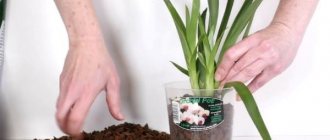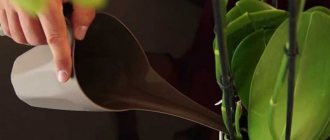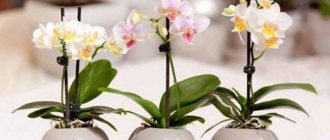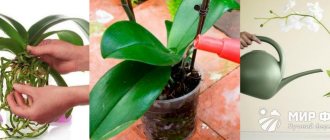The tropical beauty of the orchid will not leave anyone indifferent.
This flower grows well in Russian apartments, although it is quite capricious. The orchid is the most demanding regarding the frequency and abundance of watering, as well as the quality of water. In this article we will tell you everything about how to irrigate an orchid, as well as what nuances to pay special attention to. Dear readers! For you, we have created communities on social networks in which useful articles and interesting ideas are published several times a day! Subscribe and receive useful content in a convenient format!
How to determine that an orchid needs watering?
Irrigation should be carried out as the soil in the pot dries. The flower does not like excessive humidity, but also does not tolerate periods of drought. There are several tricks to determine the need for watering.
Look at the walls of the pot; if there is condensation on them, then there is no need to water. If the aerial roots become pale, then you need to irrigate. And, conversely, a flower with bright green roots is not watered.
If your orchid grows in an opaque pot, then you can determine the degree of dryness of the soil using a stick stuck into the substrate. Another way is to take the pot in your hands. If it is heavy, with a center of gravity closer to the bottom, it means there is still a lot of moisture in it, and there is no need to water the flower.
IMPORTANT! The liquid you will use must sit and warm up. The ideal option is to collect rainwater. When using ordinary tap or well water, reduce its hardness level with oxalic acid (half a teaspoon per three-liter jar).
What kind of water is suitable
Much depends on what kind of water is used to water tropical flowers. In the wild, orchids are watered by rain, but in our ecology, rainwater can contain a whole range of different chemical components, so it is better not to use it for watering.
The water you use to water the plants should be soft. There are many ways to determine the degree of water hardness. One of the indicators that hard water is flowing from the tap is that scale forms in the kettle very quickly.
You can buy special tests to determine the degree of water hardness, which will accurately determine how hard your tap water is. Before watering flowers, hard water should be softened.
Water softening methods
- Oxalic acid, which is diluted in water and left for a day. After this, the water must be carefully drained, being careful not to touch the sediment.
- A canvas bag filled with high-moor peat is left in the water for irrigation. Before watering, the bag is removed from the container. This method will not only soften, but also acidify the water.
- Before watering, the water is passed through a household purification filter several times.
- Quite often, experienced flower growers use boiled water at room temperature to water their flowers. When boiling, all harmful microbes are killed, chlorine is eliminated, and heavy salts precipitate.
- To improve the condition of the water used for irrigation, many add garlic, succinic acid, and potassium permanganate. Garlic water helps improve the flowering of orchids, and at the same time disinfects the plant. Amber water increases the plant’s immunity, helping the orchid to better resist various diseases. A weak solution of potassium permanganate helps disinfect the roots.
Novice gardeners make the mistake of using distilled water for watering. It is strictly forbidden to water an orchid with purified water! Distilled water is used for washing leaves, roots, irrigation, and also for diluting fertilizers.
The water temperature for irrigation should vary between 30-40 degrees. It is also important what acidity the water will have. The ideal pH level is 5.5. Check acidity using litmus paper. If the acidity level of the water is lower, add a few drops of freshly squeezed lemon juice.
How often to water an orchid?
The orchid does not require frequent watering, but it should be plentiful. The fact is that frequent addition of water entails the accumulation of moisture in the pot. And this is a direct road to the development of rot and the subsequent death of the flower.
At the same time, you need to water the plant abundantly so that the orchid drinks enough. Due to lack of moisture, the growth of the orchid will slow down and flowering will become poor.
How often you water is directly dependent on 2 factors: the time of year and the phase of plant development.
In winter, you need to water the orchid no more than 2-3 times a month. In summer, watering is carried out more often - every 3-4 days, plus it is additionally necessary to increase the air humidity. For example, using a saucer filled with water placed next to the orchid.
Watering methods
An orchid is a very capricious flower that needs to be watered in different ways. Let's take a closer look at them.
Hot shower
Watering is carried out from a watering can with very warm (40 degrees) water. The water pressure should not be strong. It is necessary to water until the soil under the orchid is completely saturated.
After the procedure, let the water drain and the plant rest a little. Then carefully remove excess moisture from the leaves, axils and shoots. There is no need to immediately move the plant to a cold room, otherwise it will get sick. So give him some time to “come to his senses.”
This method of watering imitates a tropical rainfall and also removes dust and dirt from the flower.
IMPORTANT! With this method of irrigation, it is not advisable to use tap water. It is not suitable for an orchid. Better buy a small watering can with a nozzle.
Spraying the roots
This method is used for flowers that grow without a substrate. They need to be irrigated as often as possible, since their need for moisture is higher. The procedure is carried out in the morning. Select the finest spray on the spray bottle so that the water looks like fog or suspension.
Interestingly, this irrigation method can occasionally be used for those orchids that are grown in the usual way.
Watering into a tray
It is best to grow an orchid in a special pot with a deep tray. Then watering the flower is done by adding water to this pan. The substrate is gradually saturated with water. As a result, the pot maintains the optimal level of humidity required for the flower.
Dive
This method is reminiscent of watering in a tray, which is usual for orchids. Only you simply lower the orchid pot into a prepared container with liquid for 10 minutes. This time is usually enough for the soil in the pot to become saturated with liquid. But be careful! Neither the stem, nor the leaves, and especially the flowers, should touch the water in the pan.
Surface watering
And this is the most common watering method. Using a watering can with a long spout, you carefully pour the liquid over the entire surface of the substrate. Water should flow out of the drainage holes. You need to repeat the procedure several times. This method is used only for morning moisturizing.
Choosing a system for indoor views
Some varieties have specific moisture requirements.
- Dendrobium - requires plenty of moisture in spring and summer. The most effective method is immersion in room water for 5-10 minutes.
- Lady's slipper (paphiopedilum) - is not capable of retaining water, therefore it requires constant moistening and maintaining moisture in the substrate.
- Cymbidium - use the immersion method for 40 minutes or watering with a watering can for 10-15 minutes.
- Cambria - spraying is not used for these flowers. It is necessary to allow the soil to dry completely.
- Vanda - watering is done only after the soil dries. A hot shower with a temperature of 35-40 degrees is effective.
Read about what irrigation methods to use for phalaenopsis orchids in this article.
How to water at different times?
Depending on the time of year, some nuances of the procedure vary. Let's look at them in a little more detail.
in winter
In winter, the orchid most often “rests,” so it rarely needs to be watered. For normal growth and development of the flower, one irrigation every two weeks will be enough. At the same time, be sure to monitor the air humidity. Due to the central heating radiators, the apartment may be too dry for the flower. However, you cannot spray the flower at this time of year.
In summer
During the summer months, the orchid requires a lot of liquid. You will have to water the flower every 3-4 days. Also, do not forget about a hot shower and spraying. To maintain the required level of humidity, place a saucer with wet pebbles, water or moss next to the orchid pot.
Spring and autumn
In spring, watering becomes more frequent compared to the winter months. At this time of year, you need to gradually switch to the summer watering schedule. In autumn, on the contrary, the number of water procedures is gradually reduced. However, it is still possible to carry out sanitary spraying to wash away dust and dirt from the leaves and give them a decorative appearance.
Features of watering orchids depending on the growing season
Growing seasons also make adjustments to the irrigation regime. Let's look at how to water an orchid at different stages of its growth.
Watering an orchid during flowering
During the phase of active peduncle formation and immediate flowering, the orchid requires more watering. But you need to pour water very carefully so as not to accidentally drip on the flowers. If your plant blooms in the warm months, then you need to water it about once every 4 days. If flowering occurs in the winter months, then you need to irrigate a little less often, approximately every 7-8 days.
How to water during dormancy
After flowering has ended, the substrate in the pot with the orchid is allowed to dry completely, a couple of days are counted, and then the orchid is watered. At this stage of plant development, you need to irrigate the flower no more than once every 2 weeks. In this case, you do not need to add a lot of liquid.
How to do the procedure after transplantation
As soon as you have transplanted the orchid, the soil in the pot must immediately be completely saturated with moisture. The immersion method is more suitable for this. It is necessary to lower the pot into the tray for half an hour. After this, the flower is left alone for 2 weeks, and then the watering procedure is repeated.
Why is dampness dangerous?
Excessive moisture harms not only the root system of the flower, which begins to rot, but also affects the condition of the substrate in which the flower grows. It begins to thicken and is also subject to putrefactive processes. As a result of excessive watering, the plant begins to get sick and eventually dies.
How to revive a flower with excess water?
- The plant is removed from the pot by shaking off excess substrate from the roots.
- The root system is placed in water for fifteen minutes, and then all damaged and rotten areas of the roots are removed with a sharp knife.
- Then the plant is transplanted into a new pot, which is pre-treated with a soap solution. The horse system is carefully straightened out among the substrate poured inside.
After this procedure, the flower should begin to come back to life.
Watering orchids for different types has slight or significant differences. When choosing a flower for yourself, you should pay attention to plants that are easy to care for, so as not to spend a lot of time on it and not resort to various tricks for proper cultivation. Exact recommendations for watering the selected variety can be obtained from a specialist florist at a flower shop.
The quality of water, namely its composition and temperature, largely determines the well-being of a houseplant. If in the open air the rainwater that an orchid receives contains almost no mineral salts or acids, then in the moisture passed through water pipes you can find the entire periodic table, complex inorganic compounds, organics and even microflora. Such a rich “cocktail”, falling on the roots of the flower and on pieces of the substrate, settles and can have the most unpredictable, but rather negative, effect on the plant.
How to water orchids depending on the variety and varieties, table
In the table below we have collected the most important aspects of watering the most popular varieties of indoor orchids.
| Variety of flower | Nuances of watering |
| Wanda | The preferred method is a hot shower. Irrigate only when the soil substrate is completely dry. |
| Lady's slipper | Regular watering: every 3-4 days in summer, every 7-8 days in winter. Do not allow the roots to dry out, as this can lead to the death of the flower. |
| Dendrobium | Abundant irrigation in spring and summer using the immersion method (keep in water for up to 1 hour). Reduce the frequency and volume of fluid administered during the rest period. |
| Cumbria | Spraying is not allowed. Water only when the soil is completely dry. |
| Cattleya | Water only when the soil in the pot dries completely. Increase watering when the ambient temperature rises. |
| Miltonia | During the warm season, irrigate three times a week. Do not allow the substrate to become waterlogged or dry out. |
| Oncidium | Abundant irrigation until pseudobulbs form. Then watering is stopped until flowering begins. |
| Phalaenopsis | During the budding and flowering phases, the flower is irrigated every 3 days. During the rest period - once every week and a half. During the stage of active growth and accumulation of green mass, irrigation is carried out every week. |
| Cymbidium | Preferred irrigation methods: submersion and surface irrigation. In summer, irrigation is once a week, in autumn - once every 1.5 weeks, in winter - once every 2 weeks, in spring - once a week. |
Top dressing
There are high-quality fertilizers on sale that are designed specifically for orchids (“Ideal”, “Rainbow”, etc.). Fertilizing is carried out every third watering in the spring season; in summer, the application of nitrogen fertilizers is reduced. The frequency of fertilizing also depends on the period of plant life - in the dormant stage it is lower.
To feed orchids, only special fertilizers are used.
Feed the plants for 30 minutes by submersion or bottom watering, adding liquid fertilizer to the water. Orchids grown without substrate are sprayed with the prepared solution (1 part fertilizer - 6 parts water).
How to spray correctly?
Spraying should be fine. The procedure is carried out from a distance of at least 20 cm so that large drops of water do not fall on the leaves.
Water for spraying must meet all the orchid’s liquid requirements, that is, be warm, settled and soft.
It is forbidden to spray those plants that have been in the sun for a long time. The procedure is not carried out in winter.
Improper watering and plant diseases?
As mentioned above, the orchid needs to be watered infrequently, but abundantly. A special feature of this plant is its ability to accumulate water in its tissues. If you water the plant too often, excess moisture will accumulate in the pot. As a result, this will lead to the development of putrefactive processes and fungal diseases.
ON A NOTE. Improper spraying is a common cause of leaf burns.
If you have several orchids, then when irrigating using the immersion method, the water must be completely changed. Otherwise, there is a chance to infect all the flowers.
What to do if the orchid is overwatered
The first sign that an orchid is flooded is darkened, wrinkled roots. Second, the leaves begin to turn yellow, wrinkle and fall off. All this ultimately leads to the death of the plant.
You can save the flower by replanting. Read about how to properly carry out this procedure in our article “Transplanting a Phalaenopsis orchid at home.”
What to do if the flower has dried up
At the first signs of drying, watering should be resumed immediately. The main symptoms of a lack of fluid are a drying flower, yellowed and limp leaves.
During resuscitation procedures, spraying and irrigation should be carried out using the immersion method.
However, there is no guarantee that the flower can be saved. Therefore, simply do not bring the plant to the point where it needs to be urgently saved.
Possible mistakes
Let's look at possible mistakes in irrigating orchids.
- Water remains in the sinuses and floods the growing points. Because of this, the orchid begins to rot. Fungal diseases develop, which lead to the death of the plant.
- Improperly prepared liquid. Cold or hard tap water is not suitable for this plant.
- Spraying at close range . Water during spraying should be in the form of a suspension. If you spray from a distance of less than 20 cm, large drops will fall on the leaves, flowers and axils.
- Excessive irrigation. This leads to rotting of the root system and death of the flower.
- Lack of watering. The opposite situation. The orchid grows poorly and blooms poorly. The plant loses its decorative effect.
Signs of lack of moisture
Orchids are very sensitive to lack of moisture . Main signs of water shortage:
- the open root system takes on a gray tint;
- folds on the bulb;
- the pot with the plant becomes much lighter;
- you can stick a wooden stick into the soil for several hours - in the dried substrate it will remain absolutely dry;
- if the plant is planted in a transparent pot, then there will be no drops of condensation on its walls.
It is better to water in the morning when the sun appears. With 24-hour lighting, watering can be done at any time.
Answers to frequently asked questions
Which watering method is best to choose?
You need to focus on the type of orchid. In general, it is better to alternate all methods. This way you will recreate the natural growing conditions of this plant as accurately as possible.
What kind of water does an orchid like?
Warm, not hard, settled. Experienced florists boil the liquid to kill all germs. The ideal option is to collect rainwater. But not everyone can afford it. So settle the irrigation liquid and warm it before the procedure.
How to accurately understand that a flower needs to be watered?
It is best to grow an orchid in a clear plastic pot. Then the need for irrigation can be determined visually. Otherwise, use a sharp stick to pierce the substrate. If the stick is wet, there is no need to water it.
Main principle
The orchid is strikingly different from other flowers because it is an epiphyte. This means that under natural conditions the flower grows on tree trunks and does not develop in the soil. The root system does not contact the ground, and obtains nutrients from the surrounding space. In nature, the only source of moisture for an orchid is rain.
The roots do not stay in a humid environment for a long time. Based on this important feature, we can formulate the main principle of watering orchids in pots: you cannot leave the plants in water for a long time and do not fill them , so you should not plant orchids in ordinary soil; they require a special substrate.











